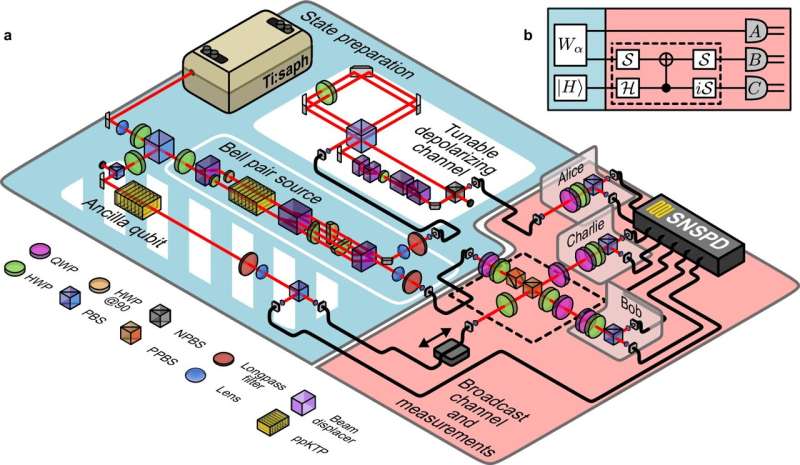Schematic overview of the experiment. Credit: nature communications (2024). DOI: 10.1038/s41467-024-47354-w
An experiment shows how networks can be used to combat damaging “noise” in quantum communications, marking a major milestone in quantum communications technology.
An international effort led by researchers at Griffith University’s Center for Quantum Dynamics has highlighted the potential of quantum networks to revolutionize communication technology at the quantum level.The research “Non-local activation in photonic quantum networks” has been published in nature communications.
Researchers Dr Nora Tischler and Dr Sergei Slussarenko, project managers of the ARC Center of Excellence for Quantum Computing and Communication Technologies (CQC2T) node at Griffith University, believe their discovery is the first step towards large-scale quantum networks that could Fundamentally solve the problem of quantum networks.
The research delves into the complex world of quantum entanglement – a phenomenon in which particles remain connected regardless of the distance between them. Quantum entanglement has long been considered a cornerstone of quantum technology, piqued by scientists for its potential applications in ultra-sensitive sensors and ultra-private communication channels.
CQC2T PhD researcher Luis Villegas-Aguilar joins a team at Griffith University on a journey to explore the relationship between quantum entanglement and non-locality – Ein Stein calls this mysterious correlation “spooky action at a distance.”
The degradation of these quantum effects due to noise poses significant challenges to realizing their practical applications. The experiments conducted by the research team addressed this challenge head-on.
“Essentially, our experiment shows how networks can be used to overcome noise in quantum communications,” Villegas-Aguilar explains. “By simulating real-world conditions in a controlled environment, we aim to enhance noise tolerance within network structures and ‘activate’ quantum nonlocality.”
To achieve this, they teamed up with researchers from the University of New South Wales, France’s Sorbonne University, and the U.S. National Institute of Standards and Technology. The team built a three-station quantum network in the lab, mimicking configurations that may appear in a future quantum internet.
“In our experiments, we send entangled particles to different stations within the laboratory. We use entangled single photons, which are quantum particles of light,” Dr. Tischler said.
“The three-station quantum network simulates the noise conditions one might encounter in larger field-deployed networks. First, we started with just two entangled photons and showed that they are unable to produce quantum nonlocality beyond certain noise limits. “
Then, through careful design and implementation, the researchers observed a remarkable phenomenon: the previously lost quantum nonlocality could be restored by adding additional connection links.
“We observed that adding a third station to the network configuration allowed us to overcome the effects of noise and activate quantum nonlocality,” said Dr. Emanuele Polino, a postdoctoral researcher involved in the experiment.
The team believes their results not only advance our understanding of quantum phenomena, but also pave the way for the development of resilient and robust quantum technologies.
As the world continues to move toward the age of quantum computing and communications, this research represents an important milestone in harnessing the full potential of quantum mechanics.
More information:
Luis Villegas-Aguilar et al., Non-local activation in photonic quantum networks, nature communications (2024). DOI: 10.1038/s41467-024-47354-w
Provided by Griffith University
citation: Combating disruptive “noise” in quantum communications (2024, April 15), retrieved April 19, 2024, from https://phys.org/news/2024-04-combating-disruptive-noise-quantum -communication.html
This document is protected by copyright. No part may be reproduced without written permission except in the interests of fair dealing for private study or research purposes. Content is for reference only.
#Combating #disruptive #noise #quantum #communications
Image Source : phys.org
